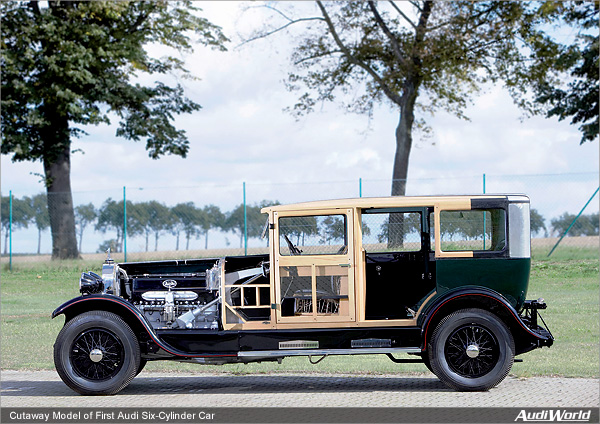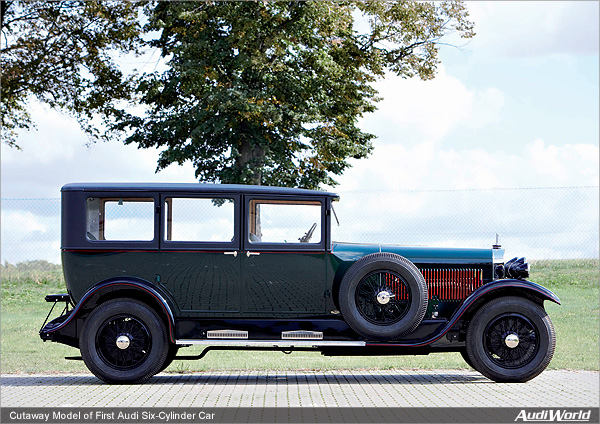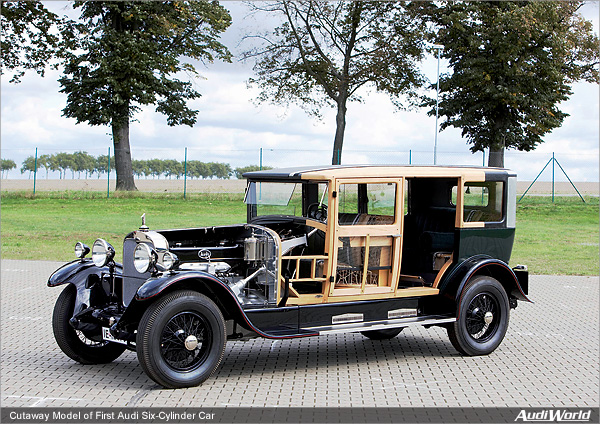Cutaway Model of First Audi Six-Cylinder Car

heritage department of AUDI AG has an appointment of particular note today: Audi Tradition is taking receipt of a fully restored Audi 18/70 hp Type M, dating from 1925, from the vehicle restoration specialists at Fahrzeugrestaurierung Rosenow, based in Glienick near Berlin in the form of a cutaway model. “It was very important to us to be able to realise this project. After all, the cutaway model gives people a very revealing insight into the technology, the composition of the materials, the craftsmanship and the engineering expertise of its time,” remarked Thomas Frank, Head of Audi Tradition. The conscious decision was taken to commission the preparation of a cutaway model from a very valuable and rare original vehicle. Frank is thrilled by the results: “This represents the pinnacle of automotive craftsmanship every single detail, however tiny, is visible! The Audi Type M is a real eye-catching exhibit that will be positioned at a prominent point at the Audi museum mobile.” Audi Tradition is consequently allowing itself a rare luxury, because it is rare for cutaway models of such remarkable cars to be commissioned today. The Audi 18/70 hp Type M from 1925 is one of four surviving specimens worldwide. In April, the company Fahrzeugrestaurierung Rosenow was awarded the contract to create a cutaway model from what was the first six-cylinder car in Audi’s history. “That was a real challenge to our craftsmanship,” stressed company owner Peter Spillner. The planning aspect, for instance, was much more elaborate than for a conventional restoration project. “The demands placed on everyone working on the project were incredibly high, because the bodymakers, leatherworkers and cartwrights had to keep coordinating their efforts,” commented classic car specialist Spillner, who summarised by saying: “Half a car is double the work”. Spillner and his team devoted around 4,500 hours’ work, spread over three and a half years, to this rare car. Although the original chassis was well preserved, it needed full optical reconditioning. The vehicle floor is made from acrylic glass, to provide a good view of all the car’s chassis components. The smooth, elegantly styled engine block of the 70 hp car can still be admired intact. “It would have been simply unforgivable to cut this precious engine in half,” in the words of Spillner.
The body, which was originally built by the Zittau-based company Gustav Winter, had survived but was in poor condition. Parts of the wooden frame and metal body panels, together with fragments of the doors and the sill plates, formed the basis of the entirely rebuilt body. The composite wood and steel structure can be clearly seen on the cutaway model: the metal body panels are bolted to the beech frame acting as the body’s supporting structure, then filled and painted. The cushions are cut away to reveal the sheer artistry that has gone into the leatherwork. “The 1925 Audi Type M was our oldest and most intricate car restoration project to date, but there’s nothing we love more than a special challenge,” summarised restorer Peter Spillner. The giant Audi 18/70 hp Type M was one of the key attractions at the Berlin Motor Show in December 1924. Audi’s much-publicised philosophy was about building technically elaborate vehicles of a very high calibre. The six-cylinder engine with light alloy crankcase, valve timing with overhead camshaft and four-wheel brake were the most notable new features. The brake system was mechanical/hydraulic, and the Audi Type M was the first to feature hydraulic shock absorbers. The bulky body of Audi’s first six-cylinder model had a wheelbase of 3.75 metres. However, Audi itself built only the chassis. The bodywork, which was placed on top of the chassis according to a modular principle, was manufactured by such companies as Winter of Zittau, Hornig of Meerane, Kathe of Halle, and the Dresden-based Gläser. The body was available to customers in five different versions: an open-top tourer, a Pullman saloon, a Pullman landaulet, a Pullman convertible and a roadster convertible. The restored model is a Pullman saloon. 228 of the Audi Type M were built in total between 1925 and 1928. Audi Werke gave visible expression to its ambition to become the leading German car manufacturer: from 1924 on, all cars were adorned with a “1” as the radiator emblem with a recessed coolant temperature gauge that was visible from the driver’s seat on the large models. The six-cylinder Audi Type M was an innovative car, but little regard was given to cost in its design and production. As a result, the Audi Type M was technically a very interesting vehicle but it did not help to strengthen the company’s economic position. The four rings of the Audi badge symbolise the brands Audi, DKW, Horch and Wanderer, which were combined under the umbrella of Auto Union in 1932. Auto Union and NSU, which merged in 1969, made many significant contributions towards the development of the car. AUDI AG was formed from Audi NSU Auto Union AG in 1985. Together with the two tradition companies Auto Union GmbH and NSU GmbH, Audi Tradition nurtures and presents the deep and diverse history of Audi. The Audi museum mobile at the Audi Forum Ingolstadt is open daily from Monday to Sunday, from 9 a.m. to 6 p.m.
|


